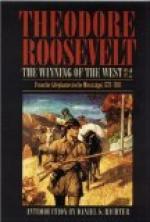The appointed meeting-place was at the Sycamore Shoals of the Watauga. There the riflemen gathered on the 25th of September, Campbell bringing four hundred men, Sevier and Shelby two hundred and forty each, while the refugees under McDowell amounted to about one hundred and sixty. With Shelby came his two brothers, one of whom was afterwards slightly wounded at King’s Mountain; while Sevier had in his regiment no less than six relations of his own name, his two sons being privates, and his two brothers captains. One of the latter was mortally wounded in the battle.
To raise money for provisions Sevier and Shelby were obliged to take, on their individual guaranties, the funds in the entry-taker’s offices that had been received from the sale of lands. They amounted in all to nearly thirteen thousand dollars, every dollar of which they afterward refunded.
The March to the Battle.
On the 26th [Footnote: “State of the proceedings of the western army from Sept. 25, 1780, to the reduction of Major Ferguson and the army under his command,” signed by Campbell, Shelby, and Cleavland. The official report; it is in the Gates MSS. in the N. Y. Hist. Society. It was published complete at the time, except the tabulated statement of loss, which has never been printed; I give it further on.] they began the march, over a thousand strong, most of them mounted on swift, wiry horses. They were led by leaders they trusted, they were wonted to Indian warfare, they were skilled as horsemen and marksmen, they knew how to face every kind of danger, hardship, and privation. Their fringed and tasselled hunting-shirts were girded in by bead-worked belts, and the trappings of their horses were stained red and yellow. On their heads they wore caps of coon-skin or mink-skin, with the tails hanging down, or else felt hats, in each of which was thrust a buck-tail or a sprig of evergreen. Every man carried a small-bore rifle, a tomahawk, and a scalping knife. A very few of the officers had swords, and there was not a bayonet nor a tent in the army. [Footnote: Gen. Wm. Lenoir’s account, prepared for Judge A. D. Murphy’s intended history of North Carolina. Lenoir was a private in the battle.] Before leaving their camping-ground at the Sycamore Shoals they gathered in an open grove to hear a stern old Presbyterian preacher [Footnote: Rev. Samuel Doak. Draper, 176. A tradition, but probably truthful, being based on the statements




